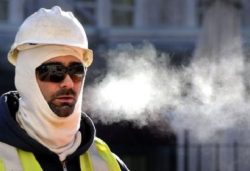
Personal Protective Equipment and Winter Weather
It’s important to choose protective clothing that is suitable for the temperature, the work you will be doing, and the physical exertion that us required by the task.
Warm clothing can help prevent a number of cold-weather hazards, such as frostbite and hypothermia. Cold temperatures can also reduce your mental alertness and manual dexterity which can lead to dangerous situations. The following tips can help you choose the right kind of clothing for cold weather:
- Wear several layers of clothing rather than one thick layer. The air that’s captured between the layers is an insulator.
- Don’t have your clothing so tight that it restricts your movements.
- If the weather is wet as well as cold, be sure your outer clothing is waterproof, or at least water-repellent.
- Wind-resistant fabrics may also be necessary under some conditions.
- Encourage the use of hats and hoods to prevent heat loss from the head and to protect the ears.
- Tight-fitting footwear restricts the blood flow. Footwear should be large enough to allow for either one thick pair of socks or two thin pairs. Wearing too many socks can tighten the fit of footwear and harm rather than help.
- If you get hot while you’re working, open your jacket but keep your hat and gloves on.
- When you put on extra layers of clothing for warmth, make sure none of it will pose a hazard, such as by catching on machinery.
TYPES OF WINTER PPE
When it gets cold, everyone has a tendency to put on the heaviest clothing available to stay warm. While heavy clothing is sometimes necessary, selecting clothing and PPE that is suitable for the tasks being performed is the most important thing to do. There types of PPE may be useful for your employees who work in cold, wet or windy environments.
LAYERED CLOTHING
Wearing multiple layers of clothing can actually keep a person warmer than one heavy layer. This is because the air trapped between the layers acts as an insulator.
When putting on layers, employees shouldn’t use just any type of clothing. Wool or synthetic materials are best, as these can wick away moisture and help retain body heat even when wet. Cotton, on the other hand, can get soaked with sweat and make the wearer colder. These layers should also not be too tight, as tight clothing can restrict movements and decrease the insulating effect of the layers.
COATS AND JACKETS
Insulated coats can provide needed warmth for outdoor workers.
In very cold environments, insulated coats or jackets are often necessary as a top layer. In other cases, a top layer that is water- resistant, waterproof or wind- resistant will be a better option. Keep in mind that once a person gets wet, he or she will begin to feel cold and uncomfortable, so fabric matters.
FOOTWEAR
Depending on the type of work being performed, waterproof or insulated boots may be needed. Workers who will be standing in slush, for example, will require footwear made from waterproof materials. For other workers, boots with rubber bottoms and leather tops might be the best option because the leather still allows perspiration to evaporate.
Footwear must also be large enough to comfortably fit two pairs of thin socks or one pair of thick socks. If boots are too tight, blood flow could be restricted.
GLOVES AND MITTENS
Gloves and mittens can reduce dexterity, but in cold work environments, employees will often need this hand protection. Opt for insulated gloves when temperatures approach freezing. When temperatures approach zero, have workers wear mittens, which can keep there fingers warm.
HEAD PROTECTION
According to the Canadian Centre for Occupational Health and Safety (CCOHS), about 50 percent of body heat is lost through the head. For workers who don’t need to wear additional head protection like hard hats, a wool hat that covers the ears will help retain heat. For those who do need to wear hard hats on the job, winter hardhat liners are a good idea.
In very cold situations, workers may also want to wear a knit masks that cover the face.
EYEWEAR
Having glasses for up when your trying to preform a task isn’t only annoying; it can also be dangerous. CCOHS explains that breathing in cold weather can cause PPE like goggle and safety glasses to fog or frost, so when possible, this protection separated from the nose and mouth.
